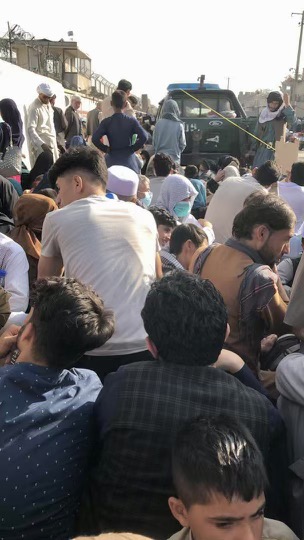Taliban Takeover of Afghanistan

Photo by B. Hameedi.
Ramin Hameedi’s mother and sister at a Taliban checkpoint on the road to the airport. In the top right corner, a Taliban member is visible.
Afghanistan and The United States: 7,410 miles separate these nations, yet they are undeniably intertwined. Beginning in May 2021, The United States ended its direct presence in Afghanistan after 20 years. This departure caused the government to crumble and the Taliban to seize control. Now, 2.6 million refugees have fled the country, with millions trapped without sanctuary. The fate of these people may seem far-removed from the worries of Bingham High School students, but by learning about their lives, the distance can fade away.
It is vital to know who the Taliban is and what they want in order to understand the current crisis. The Taliban is an Islamist militant group that came to power in Afghanistan during the 1990s and strictly enforced their interpretation of Sharia law, including public executions and amputations of convicted criminals. Taliban policy also disapproved of female education over the age of 10, which is difficult to imagine while sitting in a classroom at Bingham High. Other bans included restrictions on clothing, television, movies, and music.
In response to the terrorist attack on Sept. 11, 2001, American forces invaded Afghanistan and ended the Taliban regime. What followed was two decades of war as the Taliban waited and strategized to regain control. In May of this year, President Joe Biden announced that all American troops would leave the country.
“I stand squarely behind my decision. After 20 years, I’ve learned the hard way that there was never a good time to withdraw US forces,” said President Biden in a White House speech on August 16, 2021.
Behind every global situation, people pay the price. Images of chaotic airports and fearful refugees present the humanitarian crisis of Afghanistan. Someone who has watched this situation unfold firsthand is Ramin Hameedi. Hameedi was born in Afghanistan and immigrated to the United States after helping translate for American forces. Unfortunately, he had to leave his mother and sister behind in the capital city of Kabul.
“They do not leave the house except to go to the bank daily to draw money and go get groceries if needed. They stay out of large groups to protect themselves from bombings and the Taliban,” said Hameedi, describing the daily life of his family during the crisis.
During a desperate attempt to leave the country at the end of August, they passed through checkpoints monitored by Taliban officers trying to stop people from fleeing to the airports. The Taliban now has pictures of them, and with a close relation tied to the U.S. army, they are considered targets.
“I have been away from my family on and off since the age of 12. This has by far been the scariest knowing there is no one there to help them,” said Hameedi.
To enforce their complete control, Taliban members are visiting private residences looking for people connected to the United States. Hameedi’s mother and sister dread a knock at their door every day.
This crisis has personal significance to me because Ramin Hameedi is a member of my family. He implores Americans to “Appreciate the freedom you have here and enjoy your family because you never know when it’s impossible to see each other.”
Want To Get Involved?
Bingham students can help families such as the Hameedis by donating to charities like The International Medical Corps and The International Rescue Committee. The former has offered services and medical training in Afghanistan since 1984, and the latter aims to raise $10 million to deliver lifesaving aid.
Locally, refugees from Afghanistan can be helped by the Utah State Office for Refugees Services. They are asking for donations to help refugees establish their new lives in the United States.
What may seem a small contribution by one person can truly save lives when people unite in a cause. Bingham High School has a long history of serving its local community, and by extending help to Afghanistan, this service spreads across the world.




![Photo Credit; Miller, Kim. “City of Asheville prepares for a weekend of winter weather.” City of Asheville prepares for a weekend of winter weather [Ashville], 10 February 2023, https://www.ashevillenc.gov/news/city-of-asheville-prepares-for-a-weekend-of-winter-weather/. Accessed 06 January 2025.](https://binghamprospector.org/wp-content/uploads/2025/01/Screenshot-2025-01-14-7.54.38-AM.png)